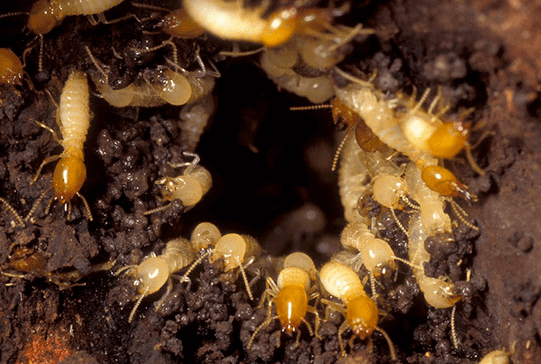When you begin to see a swarm of termites around your house, it’s disconcerting to realize that this probably means that there is a termite colony somewhere nearby. Termites have the reputation of being “silent destroyers”. But learning about termites and their swarms can help you decide if you have a problem and need termite extermination.
What is a Termite Swarm?
A termite swarm is made up of one of four types of termites in the colony. Termite colonies include workers (heavy lifting and tunnel building), soldiers (protectors against predators), kings & queens (responsible for reproduction). Swarmers (called “alates”) are the forth type of termite—winged creatures which are leaving the colony in groups in order to start a new colony.
The presence of swarming termites is a strong indicator that there is a thriving termite colony somewhere nearby, as this happens when the first colony is at full capacity and needs to expand. Springtime and autumn are both seasons when most termites have a tendency to swarm in the Houston area, but some types of Texas termites may swarm in the summer as well.
Early Warning Signs of Termites
Although swarming termites certainly a warning that you need to look into termite treatment, it’s best if you don’t wait until the problem gets that far. Performing a preemptive termite inspection on our property may be helpful in allowing you to find early signs indicating the need for termite pest control.
Read More: 3 Reasons Termites Can Go Undetected
Discarded wings
Look for these, particularly near doors and windowsills made of wood. When swarmers leave their colonies and launch into flight, they pair off before shedding their wings and mating to repopulate. Finding wings around your home may indicate that you’ve had a swarm nearby.
Fecal Matter
Sometimes termites leave a trail of fecal matter behind them. Look for small droppings or piles that are light brown in color.
Wood Damage
Soft wood that sounds a bit hollow is damaged. Pieces of wood that are blistering or dark may also be damaged by termites. Painted wood that is uneven or bubbling may be a sign of moisture buildup, this could indicate termites or water damage. And soft, water damaged wood is particularly attractive to termites.
Mud tubes
Termites that live underground often burrow through mud near a home’s foundation, leaving tubes that allow them to travel between their food source and their colony.
The Difference Between Termites and Flying Ants
Although they might look similar, making the distinction between swarming termites and flying ants is critical in determining your need for termite treatment. Termites have broad middles while ants have narrow waists. Termites have two pairs of wings of equal length, while the two pairs of wings that an ant have are different in lengths. If you can look at a magnifying glass, you’ll notice that the antenna on a termite is straight but an ant has a bowed antenna. Flying ants also have longer legs and three segments in their bodies. If you find that you have flying ants, you’re in luck because handling them is not nearly as difficult as termite extermination.
What to Do if You Think You May Have Termites
If you see a termite swarm, this is not only a sign that you may have a termite infestation, but it could also mean that you have had a problem with termites for a while. Termites can enter your home quietly and cause destruction before you even know they are there. By the time you find a termite swarm, you may find that damage has always been caused. Whether you have seen a termite swarm or have found evidence after a termite inspection, the next step is to immediately contact a local termite pest control professional. The sooner you reach out for help, the more quickly you will be able to solve the problem and prevent further termite pest control problems.



